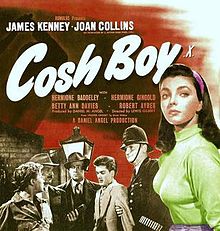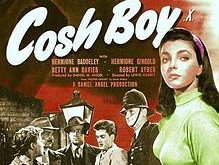Cosh Boy *** (1953, James Kenney, Joan Collins, Betty Ann Davies, Robert Ayres, Hermione Baddeley, Hermione Gingold) – Classic Movie Review 11,116
‘Call me a gangster or a mobster… but not a delinquent!’
Director Lewis Gilbert’s 1953 British black and white noir drama Cosh Boy is quite bad – but with a really good cast, and it is very interesting as an early British look at teen culture and as a reflection of how Britain was just after the World War Two war. It is based on the play Master Crook by Bruce Walker and was made at Riverside Studios in Hammersmith. It is reckoned to be the first British film to get the new X certificate. The film was retitled The Slasher for release by Lippert Pictures in the US because the Americans were unfamiliar with the word ‘cosh’.
A controversary arose when the media linked the film to Derek Bentley’s crimes after the film’s release coincided with his trial. It was banned in Birmingham, Australia and Sweden. Lewis Gilbert commented in 2000: ‘Today you’d show it to 10-year-olds.’ Even so, it performed poorly at the box office.
In war-torn, bombed-out post-war South London, 16-year-old delinquent Battersea ‘Cosh Boy’ Roy Walsh (James Kenney) and his band of thugs mug old ladies. With no father figure in the house, Kenney’s doting mum Elsie Walsh (Betty Ann Davies) and Gran (Nancy Roberts) just can’t take care of him as he is on probation and gets into more serious offences. It also stars Joan Collins as Rene Collins, Robert Ayres as Bob Stevens, Hermione Baddeley as motherly Mrs Collins and Hermione Gingold as friendly prostitute Queenie.
Elsie is involved with Canadian Bob Stevens, hated by Roy, who becomes infatuated with Rene, a gang member’s sister, but she already has a boyfriend in Brian (Michael McKeag), whom the gang beats up.
This well-meaning road-to-ruin moral saga is very badly dated and foolishly sensationalist. The scare-mongering script is weighed down with controlling, paranoid views about ‘young people today’ and old-fashioned ideas about the place of women. However, the performances are good, especially by Kenney, Collins, Davies, Baddeley and Gingold, and it is a fascinating snapshot of the time and insight into the era.
Writers: Bruce Walker (play), Lewis Gilbert (screenplay), Vernon Harris (screenplay). The play Master Crook by Bruce Walker, originally titled Cosh Boy, debuted at the Embassy Theatre in 1951 starring James Kenney.
Joan Collins recalled it as ‘a shop girl’s melodrama and the public loved it. I enjoyed working with Jimmy [Kenney] and all the other young actors. The director, Lewis Gilbert, was adorable to me, and good to work with.’
Also in the cast are Stanley Escane, Sean Lynch, Johnny Briggs, Michael McKeag, Edward Evans, Laurence Naismith, Frederick Piper, Walter Hudd, Sidney James, Cameron Hall, Arthur Howard, Ian Whittaker and Peter Swanwick.
Cosh Boy is directed by Lewis Gilbert, runs 75 minutes, is made by Romulus Films and Angel Productions, is released by Independent Film Distributors (1952) (UK) and Lippert Pictures (1953) (US), is written by Lewis Gilbert and Vernon Harris, based on the play Master Crook by Bruce Walker, is shot in black and white by Jack Asher, is produced by Daniel M Angel and is scored by Lambert Williamson.
This is how the film starts, setting the tone: ‘Cosh Boy portrays starkly the development of a young criminal, an enemy of society at sixteen. Our Judges and Magistrates, and the Police, whose stern duty it is to resolve the problem, agree that its origins lie mainly in the lack of parental control and early discipline. The problem exists – and we cannot escape it by closing our eyes. This film is presented in the hope that it will contribute towards stamping out this social evil.’
Boys in early 1950s British gangs adopted Edwardian-era fashions and were known as cosh boys, but they later became known as teddy Boys after a 1953 Daily Express newspaper headline shortened Edwardian to Teddy.
James Kenney (1930–1987) committed suicide, age 56.
Johnny Briggs died on 28 age 85.
© Derek Winnert 2021 Classic Movie Review 11,116
Check out more reviews on http://derekwinnert.com



